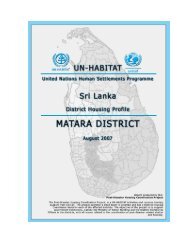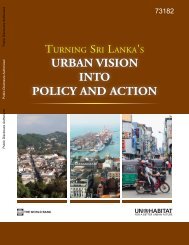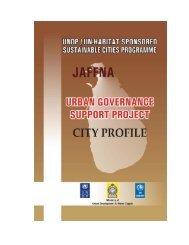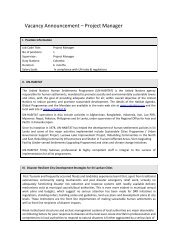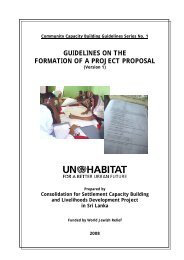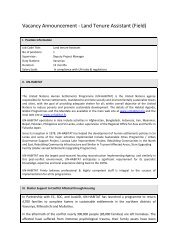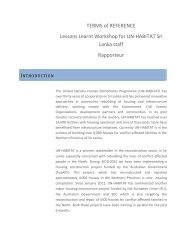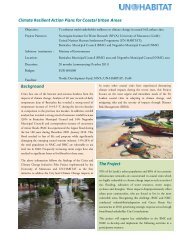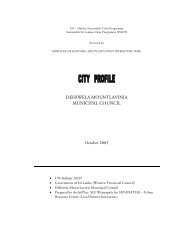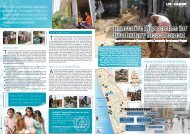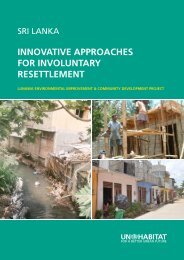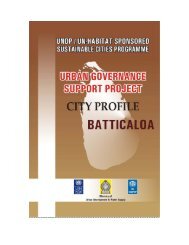Conference Proceedings : âJANASEVANAâ National ... - UN HABITAT
Conference Proceedings : âJANASEVANAâ National ... - UN HABITAT
Conference Proceedings : âJANASEVANAâ National ... - UN HABITAT
You also want an ePaper? Increase the reach of your titles
YUMPU automatically turns print PDFs into web optimized ePapers that Google loves.
In sites with a high water table, specifying a high floor level ensures a damp free environment inside the house and<br />
facilitates sewerage disposal. Sites where rain water discharge can be an issue, avoiding obstructions to natural<br />
drainage and fixing the floor level at a suitable height above the access road would be required. Construction of a<br />
house in a flood prone zone may require building it on stilts.<br />
A design allowing for un‐built areas in the plot for environmental reasons is a good practice. With strategic window<br />
placement, natural ventilation can be maximised. Choosing wide eaves to overhang the walls will provide shade from<br />
intense sun and roofs can be used for collecting rainwater.<br />
Eco‐friendly materials are those which are locally produced, natural,<br />
sustainable, and require minimal processing when they are manufactured,<br />
and non‐toxic. Materials requiring little transportation to the site, materials<br />
that are available naturally requiring minimal processing, locally produced or<br />
available, and sustainable over time are some of the considerations. Use of<br />
stone found locally in slip‐form moulds to construct walls has been<br />
successfully tried out in Sri Lanka. Stone can be used for decorative features<br />
as well as for load bearing purposes. Selecting used construction material for<br />
the building is also a useful eco‐friendly practice. However, there are certain<br />
cultural and spiritual issues in using used materials – as some people are<br />
reluctant to use these materials.<br />
Use of doors or windows from<br />
construction sites or remodelling<br />
projects is eco friendly as it eliminates<br />
the need to process new wood and<br />
eliminates waste in landfills.<br />
Inspection of the materials before<br />
removing them from locations is<br />
necessary to ascertain suitability and<br />
functionality.<br />
Specifying the over‐use of clay bricks and tiles means irreversible impacts on the environment in mining clay, leaving<br />
abandoned hazardous quarry pits and use of firewood for the burning. Use of recycled brick or concrete blocks is a<br />
good alternative option. Use of doors or windows from construction sites or remodelling projects is eco friendly as it<br />
eliminates the need to process new wood for these items and also eliminates waste in landfills. Inspection of the<br />
materials before removing them from current locations is necessary to ascertain suitability and functionality.<br />
Timber is a sensitive item in housing construction. Although the use of timber is necessary for structural reasons,<br />
excessive use of timber should be discouraged as they have very serious environmental consequences. As the felling<br />
of trees depletes forest cover, the use of timber in manufacture of building components (doors and windows),<br />
furniture and fittings should be minimized. Use of borate pressure treated wood, resistant to fungal decay and termite<br />
damage is an alternative. These trees are fast growing and replenishable in the short term, compared to userpreferred<br />
hard wood that have long term affects of depletion of permanent forest cover. Use of bamboo wood<br />
where possible which is quite hard, durable, fast growing, and naturally mildew, insect and water resistant, is also a<br />
good option.<br />
Construction methods where possible should be labour intensive, saving on machine use and energy consumed. Dust<br />
control and minimizing use of water and energy during the construction process is environmentally friendly.<br />
Purchasing only the material needed to avoid waste and planning the work to avoid over purchasing of materials is<br />
also an eco‐friendly practice<br />
Finally, on the end use of the house several environmentally friendly practices have been identified. For example,<br />
installing water saving devices in the home, on sinks, showers and the flush of the toilet, reusing water by installing a<br />
rain water tank for flushing the toilet, doing laundry and watering the garden are eco‐friendly practices. Installing solar<br />
panels for heating water and purchasing energy efficient appliances and light bulbs is an option. Therefore getting the<br />
most energy efficient household appliances that is affordable is necessary. Setting up compost bins to recycle organic<br />
material and waste is an eco friendly activity. The compost thus produced can be used as fertilizer in the garden. All<br />
these activities will contribute towards making your house more environmentally friendly.<br />
<strong>Conference</strong> <strong>Proceedings</strong> – <strong>National</strong> Housing Symposium 28



